Shmuel, son of Mordecai (Eldar), was born on 17.4.1929 in Romania, in the city of Tamorsh in northern Transylvania, where he studied in an elementary school and continued to high school in his city, in which one of the most important Jewish centers in Transylvania Jews In September 1940, a year after the outbreak of World War II, the city was annexed to Hungary, and the situation of the Jews worsened: the basic civil rights were taken away and the men were taken to the Hungarian Labor Service. The Jews of Transylvania were among the first to be activated by the “Final Solution.” In the spring of 1944, the Jews of Tamors were ordered to move to the ghetto, Hock In a brick factory on the outskirts of the city, the place was too small to accommodate everyone, and many were forced to sleep in the open air.After a short time, the Jews were deported to Auschwitz, and Shmuel’s entire family perished in the Holocaust, And after a bumpy road he arrived in Israel on April 26, 1946, as part of the Youth Aliya, and joined the youth group at Kibbutz Ramat Yohanan, where he received agricultural training, became absorbed in the company and adjusted to his new life. He was full of admiration for the first pioneers. His willingness to stand up for every call in the agriculture, at any time and at any hour, was astonishingly famous – it was a phenomenon that the members of the kibbutz had not yet encountered. Shmuel was naturally closed, and not many knew him very closely. “One of Shmuel’s characteristic lines was the stubborn rejection of any special attention, every effort for him, and he was always willing to work for others, for society, for every man who needed him, for his own help. Only those who knew him knew that despite this stubborn rejection of all help and attention, he needed – perhaps more than anything else – for love and friendship, and every slight sign of attention and emotion He is deeply immersed in his soul and remains deeply imprinted in his Lev. ” From the very start of the events that had preceded the War of Independence, Shmuel joined the Palmach, and the members of the kibbutz said that his enlistment was “wild,” and that his self-effacement suddenly became an outburst of emotion: “I can not do otherwise, I must enlist!” (“Jerusalem”) in Sodom, where he participated in the battles, then moved to the front of Jerusalem and joined the units of the Fourth Battalion (“the burglars”), which operated under the “Harel” Brigade – The 10th Brigade in the Hagana, participated in all activities around Jerusalem, showed courage and excelled in his role, and at the end of April 1948 he was wounded in the Battle of Katamon He fled from there before recovering to rejoin the ranks of the fighters and to maintain his slogan: “To fight.” Shmuel was one of the first to break into the Old City after the conquest of Mount Zion (May 18-19, 1948). At the beginning of June 1948, Shmuel participated in the Battle of the Radar, which was a British army camp on the top of a mountain in the Judean Hills, near the settlements of Ma’ale Hahamisha and Kiryat Anavim. In April 1948, during the “Yevusi” operation, Arab Legion soldiers inflicted heavy losses on the fighters of the Harel Brigade, while they rushed to the aid of their comrades in the Battle of Nabi Samuel. With the withdrawal of the British and Legionnaires from the Radar camp, in mid-May 1948, the Palmach fighters were captured and heldWas given to the fighters of the Etzioni Brigade. However, on May 26, 1948, the Arab camp was conquered by the Arabs after a fierce attack by a force of the Jordanian invasion army aided by armor and artillery. The Jordanians’ attempts to advance the armor from the radar to the kibbutzim were halted on the same day, but the fear arose that the Jordanians would exploit their success, conquer Ma’ale Hahamisha and Kiryat Anavim and block the road to Jerusalem passing by them. Therefore, it was decided to make another attempt to conquer the outpost. The attack began on the night of the 16th of Iyar 5708 (June 1, 1948), but failed against the Jordanian fortifications. Shmuel remained the only gunner during the retreat, and shortened the enemy until he fell. He was nineteen years old when he fell. The radar hill remained under the control of Jordan and at the end of the War of Independence began searching for the remnants of the fallen. Shmuel’s body remained in the field for a long time until it was collected by the military rabbinate. He was laid to rest in a mass grave in the military cemetery on Mount Herzl in Jerusalem on the 17th of Cheshvan 5710 (17.11.1949). His friends at Ramat Yohanan eulogized him: “Shmuel, you are always with us, the tent that you have built in your hands after a day’s work will be our symbol in the work, and your actions and actions will become a symbol in the war … We will always remember you, your blood is boiling in our veins, We will remember your actions and continue. ” Shmuel was immortalized in the memory room of Kibbutz Ramat Yochanan. This hero is a “last scion”. The survivors of the Holocaust are survivors of the Holocaust who survived the last remnant of their nuclear family (parents, brothers, sisters, sons and daughters) who experienced the Holocaust in the ghettos and / or concentration camps and / or in hiding and hiding in territories occupied by the Nazis and / Or in combat alongside members of the underground movements or partisans in the Nazi-occupied territories who immigrated to Israel during or after World War II, wore uniforms and fell in the Israeli army.
